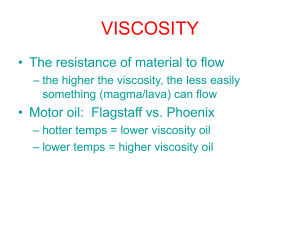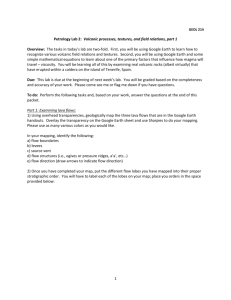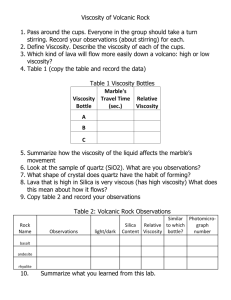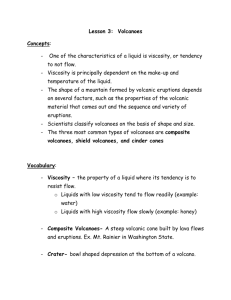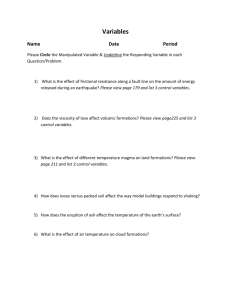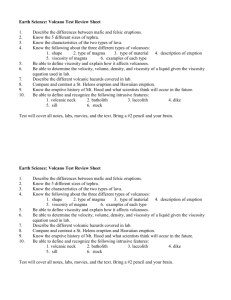Geology Teaching Resources: Mechanisms of Igneous Activity
advertisement
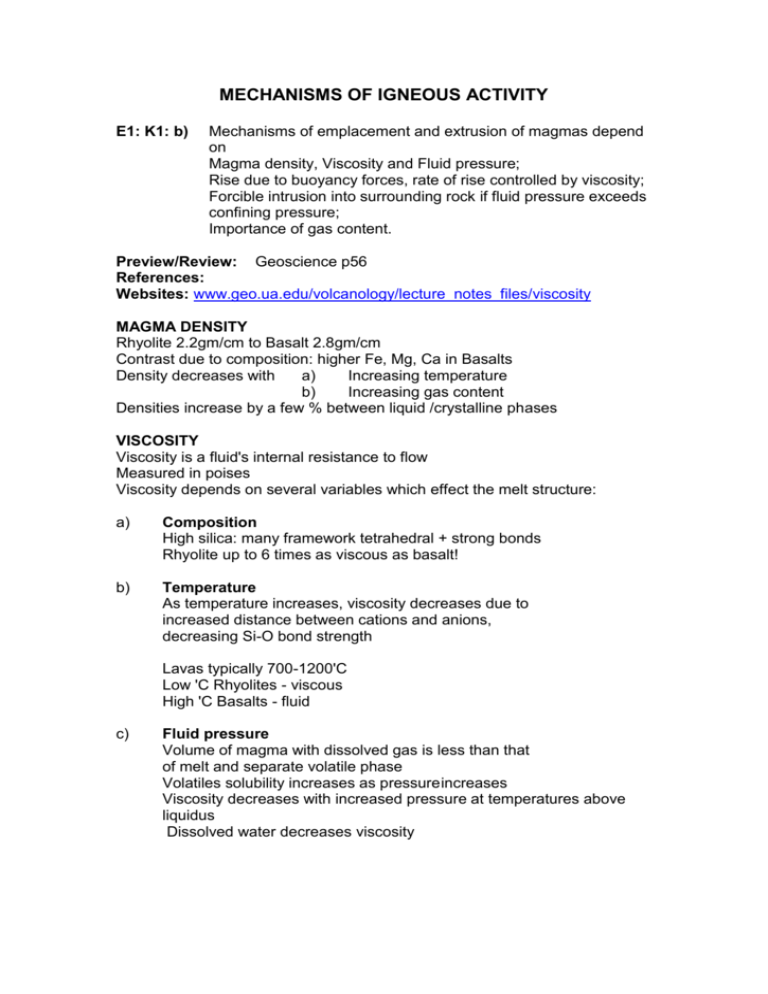
MECHANISMS OF IGNEOUS ACTIVITY E1: K1: b) Mechanisms of emplacement and extrusion of magmas depend on Magma density, Viscosity and Fluid pressure; Rise due to buoyancy forces, rate of rise controlled by viscosity; Forcible intrusion into surrounding rock if fluid pressure exceeds confining pressure; Importance of gas content. Preview/Review: Geoscience p56 References: Websites: www.geo.ua.edu/volcanology/lecture_notes_files/viscosity MAGMA DENSITY Rhyolite 2.2gm/cm to Basalt 2.8gm/cm Contrast due to composition: higher Fe, Mg, Ca in Basalts Density decreases with a) Increasing temperature b) Increasing gas content Densities increase by a few % between liquid /crystalline phases VISCOSITY Viscosity is a fluid's internal resistance to flow Measured in poises Viscosity depends on several variables which effect the melt structure: a) Composition High silica: many framework tetrahedral + strong bonds Rhyolite up to 6 times as viscous as basalt! b) Temperature As temperature increases, viscosity decreases due to increased distance between cations and anions, decreasing Si-O bond strength Lavas typically 700-1200'C Low 'C Rhyolites - viscous High 'C Basalts - fluid c) Fluid pressure Volume of magma with dissolved gas is less than that of melt and separate volatile phase Volatiles solubility increases as pressure increases Viscosity decreases with increased pressure at temperatures above liquidus Dissolved water decreases viscosity PLUTONS Granitic magma density 2.4-2.6 formed at base of continental crust density 2.9 Magma less dense than surrounding rocks - rises due to buoyancy forces Rate of rise controlled by high magma viscosity Magma stops rising when: a) It reaches rocks of the same density b) It cools and crystallizes @700'C 3-5km DYKES Discordant - cut through boundaries of country rock - often follow joints Wall-like body of rock usually 20cm-2m thick Often occur in large numbers as a DYKE SWARM May radiate or be concentric around a large pluton as RING DYKES or CONE SHEETS (may be associated with piston faulting) Cool fast - thin dykes : fine grained basalt (rarely rhyolite) - thick dykes: medium grained dolerite (rarely microgranite) Fastest cooling at dyke margins - fine grained/glassy CHILLED MARGIN Relatively small intrusions, so narrow contact metamorphic aureole: or BAKED MARGIN Cooling leads to contraction, forming polygonal COLUMNAR JOINTS at 90' to the walls of the dyke SILLS Concordant - follow boundaries of country rock - often follow bedding planes - often appear almost horizontal Few metres up to hundreds of metres thick, can have large lateral extent Because generally thicker than dykes - cool slower - commonly medium grained dolerite Thick sills may show gravity settling of early formed crystals to form CUMULATES in a LAYERED INTRUSION eg Palisades Sill New York Slow cooling allows better development of polygonal columnar jointing at90' to the cooling surface Sills often more resistant to weathering and erosion than surrounding country rocks and commonly lead to waterfall development eg High Force on the Whin Sill, which underlies a large area of N England EXTRUSIVE IGNEOUS ACTIVITY Nature of volcanic eruptions depends on lava VISCOSITY Viscosity depends on: a) Temperature High temperature - low viscosity b) Gas content High gas content - low viscosity c) Crystal content Low crystal content - low viscosity d) Composition Low silica content -low viscosity ie Basic lava: Basalt generally low viscosity Low viscosity basaltic lava (1000-1200'C) tends to be erupt EFFUSIVELY relatively quietly due to easy escape of gas Low viscosity lavas flow long distances at a few kmph before cooling, forming a) low angle 'SHIELD VOLCANOES' eg Hawaii b) widespread FLOOD BASALTS eg Deccan Plateau -India Mostly lava with few pyroclastics Surface textures may be a) ropy PAHOEHOE, due to lava flowing under a 'skin' b) blocky Aa due to gas escaping and breaking 'skin' very rough surface – painful to walk on! High viscosity andesitic or rhyolitic lava (700-1000'C) tends to erupt EXPLOSIVELY due to trapping of gas and build up of pressure Very high viscosity lava piles up around vent to form lava DOME eg Katmai (Alaska) High viscosity lava flows short distances forming steep sided volcanic cones eg Fuji, Japan Mix of alternate pyroclastics followed by lava Pyroclastics include Bombs, Blocks, Lapilli, Scoria, Pumice, Ash and dust Nuee Ardente - pyroclastic flow of hot dust and gas, forming WELDED TUFF (Ignimbrite) Very explosive eruptions can empty the magma chamber, leading to roof collapse forming a CALDERA (huge crater) eg Krakatoa, Indonesia 1883 ESTA GEOTREX The Geology Teachers Resource Exchange Contributor: Ben Church Establishment: Monmouth Comprehensive School Date:24:05:05

